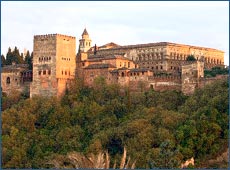|
|
|
|
 |
|
|
| » |
Barcelona's Sagrada Familia |
» |
Feria de Abril, Seville |
| » |
Prado Museum, Madrid |
» |
Picos de Europa |
| » |
Alhambra Palace – Granada |
» |
Balearic Islands |
| » |
Guggenheim Museum Bilbao |
» |
Cordoba and the Mezquita |
| » |
La Tomatina Festival, Buñol |
» |
Toledo |
| |
Alhambra Palace – Granada |
|
|
 |
| |
| The Alhambra Granada palace was a , a citadel, a fortress and home of the Nasrid Sultans, high government officials, servants of the court and elite soldiers of the Nasrid Dynasty (1238-1492), the last Islamic sultanate in the lberian Peninsula. Together with the Mezquita (Great Mosque) of Cordoba, the Alhambra is one of the most widely known of all Islamic works of art. |
| |
| The Nasrid Sultans chose as the site for their court the Sabika hill, one of the foothills of Sierra Nevada on the plain of Granada, which constituted an excellent site from which to keep watch over the capital of their kingdom and the surrounding area. From the beginning of the XIII century, the small older buildings, mainly watchtowers, some of which dated back to before the XI century, gradually grew into a huge walled site which clearly intended to be both palace and court. Within this gradual change, different stages of development, grandeur and decadence can clearly be seen through the various works of art and buildings erected over the years. The Alhambra Palace was not a single static construction, built at a specific date, but rather the result of an evolution, successive reforms and extensions. Alhambra Palace, Granada is popular tourist destination and a sight worth to visit. |
| |
|
|



